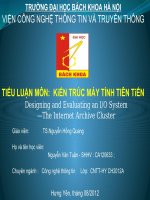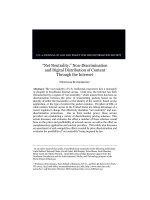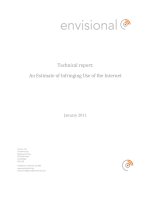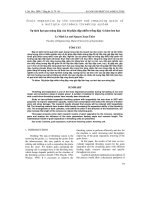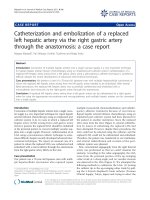TEACHING ERLANG THROUGH THE INTERNET: AN EXPERIENCE REPORT
Bạn đang xem bản rút gọn của tài liệu. Xem và tải ngay bản đầy đủ của tài liệu tại đây (134.96 KB, 9 trang )
<span class="text_page_counter">Trang 1</span><div class="page_container" data-page="1">
<small>S. Thompson (Ed.): TFPIE 2017.</small>
<small>EPTCS 270, 2018, pp. 52–60, doi:10.4204/EPTCS.270.4</small>
<small>This work is licensed under theCreative Commons Attribution License.</small>
An Experience Report
Stephen Adams
<small>sa597[AT]kent.ac.ukSchool of Computing</small>
<small>University of Kent</small>
<small>Today functional programming languages are seen as a practical solution to the difficult problems ofconcurrent and distributed programming. Erlang is a functional language designed to build massivelyscalable and fault tolerant applications. This paper describes the authors’ experiences delivering amassively online open course (MOOC) on the FutureLearn platform.</small>
The unexpected lifespan of Moore’s Law seems to be coming to the end, soon programmers will nolonger be able to rely on increases in individual processor speed to power increasingly complex soft-ware [7]. Fortunately at the same time multicore and multithreaded technology is on the rise. Imperativelanguages with their implicit global state and low level concurrency primitives make writing concurrentprograms very difficult.
Functional programming languages offer solutions to these problems. However computer scienceeducation is predominately based around imperative languages. In 2014, of the 39 top undergraduateComputer Science programs only five taught a functional programming language to their first year stu-dents [4] and more specifically in the UK under 10% of surveyed universities teach functional program-ming as the primary paradigm in their introductory courses [6]. Many learners are turning to alternativeeducation platforms to discover functional programming.
1.1 Erlang
Erlang<sup>1</sup> is a functional programming language designed to be massively scalable and highly fault erant [8]. It was originally developed in 1986 by Joe Armstrong, Robert Virding, and Mike Williamsat the Computer Science Laboratory at Ericsson Telecom AB [2]. Erlang’s core design tenets includelightweight processes, that communicate through message passing. Erlang also boasts a “let it fail” er-ror handling strategy, where processes either succeed or fail and other specialised processes handle theerror [1].
tol-Packaged along with the Erlang language is the Open Telecom Package or OTP. OTP is a set oflibraries and design principles for developing distributed, concurrent, and fault tolerant systems [8].OTP has been described as a large part of the reason Erlang is so good at these domains [5].
1.2 Erlang at the University of Kent
Though the University of Kent’s introductory programming modules are taught using Java, “Functionaland Concurrent Programming” is a mandatory stage 2 Spring term module taught since 2014. CO545’s
<small>1Named after the Danish mathematician Agner Krarup Erlang the inventor of queueing theory.</small>
</div><span class="text_page_counter">Trang 2</span><div class="page_container" data-page="2">principle language is Erlang, however Haskell is also covered to a reasonable degree towards the end ofthe course. Erlang was chosen as the principle language because of its relatively small syntax and itsmessage passing concurrency makes a stark contrast to Java’s threads.
Additionally since teaching Erlang to undergraduates is a fairly unique offering, Kent’s studentsare not only well trained in principles but are also capable of working with Erlang during their year inindustry placements. Some companies have begun taking our students for this reason<sup>2</sup>.
In early 2017 the authors had the opportunity to supervise two massively open online courses (MOOC)on the online learning platform FutureLearn, Functional Programming in Erlang<sup>3</sup>which took place fromFebruary 20 to March 10 2017 and Concurrent Programming in Erlang<sup>4</sup>(April 3 to April 21 2017). Thispaper will describe our curriculum and approach to teaching functional programming in a MOOC contextin section 2. It will also cover our experiences teaching the courses and who participated.
2Curriculum and Pedagogy
Our first attempt at teaching a MOOC happened in the Spring of 2015 as part of the University of Kent’s“Beacon Projects”<sup>5</sup>which were a part of the University’s 50th anniversary celebrations. We ran a threeweeks long pilot program, hosted through the University’s Moodle site. The pilot course’s materialswere adapted from the first part of CO545. The pilot course involved short, two to twenty minute videolectures, along with assignments for students to complete. We also brought in Joe Armstrong co-creatorof Erlang, and Francesco Cesarini the technical director of Erlang Solutions to produce “master classes”which focused on describing how Erlang was used in the real world. The master classes were madeavailable to the students at the end of the pilot course<sup>6</sup>.
We recruited participants in the pilot MOOC from the University’s current computing students andthrough social media associated with the Erlang community. Overall over five hundred people signed upfor this pilot course. At the end of the pilot course a few things became clear based on feedback we hadfrom our learners. Moodle, though not designed for the delivery of MOOCs did an adequate job. Mostof the people we surveyed were interested in taking another MOOC course on Erlang regardless of whatplatform it was delivered on. At the same time learners indicated that social learning via discussion wasimportant and a dedicated MOOC platform would have more features to support this type of learning.
Based on our experience giving this pilot MOOC we decided to develop a further three weeks ofmaterial and move our courses onto the FutureLearn platform.
Functional Programming in Erlang, the first course on FutureLearn, covered the same materials asthe pilot course but we were able to expand it to use FutureLearn’s support for quizzes, tests, and peerassessments. We also developed a second three week group of material, meant to follow the first course,about Erlang’s concurrency and fault tolerance features.
</div><span class="text_page_counter">Trang 3</span><div class="page_container" data-page="3">to give someone unfamiliar with functional programming a basic introduction to Erlang and make themready to tackle the second course on Erlang’s concurrency features.
The three weeks of the course are:
• Getting started with Erlang• Lists in Erlang
• Advanced functional programming
The first week began by introducing Erlang in fairly abstract ways. We covered some of its historyand the ways that Erlang (as well as many functional languages) differ from imperative programming,evaluating expressions and immutability, versus procedural steps mutating a global state. We then cov-ered the basics of Erlang’s syntax, including its basic data types and how pattern matching occurred. Thefinal activity in the first week introduced the idea of functions and recursion (both head and tail).
The second week was focused entirely on lists. Learners were first introduced to list syntax and howlists were constructed, pattern matched, and used in functions. Once they became familiar with the listsyntax we looked at common strategies for defining Erlang functions. Finally they were tested on theirknowledge with an assessment.
The final week introduced the learners to higher-order functions and the week’s second activity volved modelling the game rock-paper-scissors. The final activity of the course linked to the masterclasses so that people could continue their learning if they wanted and asked what people’s general opin-ion of Erlang was.
in-Following a three week break the second course on concurrency was run. Like the first courseConcurrent Programming in Erlang was three weeks long. This course’s outline is:
• Concurrency - nuts and bolts• Concurrency - making code robust• Scaling it up
The first two weeks cover Erlang’s built in features and how these features affect the design ofconcurrent systems. The third week on scaling systems introduces the learners to the Open TelecomPlatform (OTP) the set of middleware libraries for developing highly distributed systems that is includedwith Erlang [8].
The first week explained Erlang’s concurrency system, the actor model. Processes are lightweightto create and destroy and communicate with each other through message passing. Erlang’s messagingsystem is asynchronous, each process has a mailbox and will handle messages in the order they arereceived. The second week then covered Erlang’s unique error handling philosophy, “let it fail.” Erlangprocesses are expected to either succeed and if they can’t they should fail immediately without doing anyerror handling [1]. Specialized supervisor processes should be designated to monitor other processes.When children processes fail the supervisors can then take the appropriate action, such as error reportingor simply restarting the failed process.
The course finished with a bit of material about OTP. Many of the concurrent design patterns wehad our students implement in the first two weeks of the course are actually standard templates that OTPdefines.
</div><span class="text_page_counter">Trang 4</span><div class="page_container" data-page="4">Continent FP Erlang Concurrent Erlang
Australia 2 2Europe 45 50North America 18 21South America 7 8
Table 1: Percentage of enrolment by continent
2.2 FutureLearn’s Course Creation
FutureLearn provides many ways to configure and deliver online courses. Every FutureLearn course isbroken down by week, and each week is further broken down into “activities.” Each week is used tosuggest the pace that learners should aim for, and activities organise steps. Steps are the smallest sectionof a course[3].
There are several different step types that a course is built from. Each step typically hosts somematerials and a discussion section for learners to have a conversation about that step’s content. Broadlyspeaking steps can be divided into two different types which could be described as teaching steps anddoing steps. A teaching step’s primary purpose is to convey information to the learners, textual articlesand audio/video steps are examples of this. Doing steps are more interactive. They actively work toengage learners to do something, whether that be participate in a discussion, take a multiple choice quizor test<sup>7</sup>, do an exercise, or submit an assignment for peer review and review other learner’s work. Everystep type is designed to support active learning. Doing steps requires some learner interaction to pass,however, in teaching steps the learner may optionally engage in the discussion but this isn’t required tocomplete the step.
3Who participated
In the end 5,642 people enrolled in Functional Programming in Erlang and 1,965 people enrolled inConcurrent Programming in Erlang. The majority of the learners came from the UK and the USA but intotal 149 countries were represented.
Where users were located was determined based on their IP addresses. A survey was also sent out toeveryone who enrolled on the course and from the people who responded we can roughly determine theages of our learners as seen in table 2.
3.1 Prior experience
Beyond the basic demographic information we prompted the learners to introduce themselves on thefirst step of each course and to briefly describe why they were taking the course what their previousprogramming experience was. From all the responses we discovered that our learners were familiar withover 40 different programming languages. The top ten languages that people claimed to have used before
<small>7Quizzes allow for infinite attempts whereas learners only have three attempts at each test question</small>
</div><span class="text_page_counter">Trang 5</span><div class="page_container" data-page="5">Age Range FP Erlang Concurrent Erlang
Java 28JavaScript 26Python 22Ruby 17Haskell 14PHP 12
Erlang 6Scala 6
Table 3: Ten most popular languages
Language % of RespondentsHaskell 14
Erlang 6Scala 6
Clojure 4
Scheme/Racket 2ML/OCaML 1Idris <1Emacs Lisp <1
Table 4: Functional Language Popularity
are shown in table 3<sup>8</sup>.
Our learners’ experience seems very much in line with broader industry trends. Seven of the guages in table 3 also appeared in the ten most popular programming languages in the May 2017 TIOBEindex [9]. The three exceptions to this are Haskell, Erlang, and Scala who’s TIOBE ranks are 38th, 41st,and 31st respectively.
It makes sense that our learners would have a significant interest in functional programming guages prior to joining our course. Table 4 shows the number of people with experience in functionallanguages only. A very common reason why learners wanted to take our course was that they wantedto improve their understanding of functional programming techniques independently of the language thecourse was taught in.
lan-4What happened
This section describes our experience running both of these courses. We had previously ran the pilotMOOC so we weren’t completely new to the concept of MOOCs but this was our first time using theFutureLearn platform in particular and these courses were an order of magnitude larger than our pilotcourse.
<small>8The percentages in table 3 sum to greater than 100% due to single respondents having experience with multiple ming languages.</small>
</div><span class="text_page_counter">Trang 6</span><div class="page_container" data-page="6">program-4.1 Participation
If you don’t have experience running or taking an online course before it may seem unmanageable fortwo people to run a course with over 5,000 people in it, but of those people enrolled only a fractioneven begin the course and a fraction of those finish it. FutureLearn categorises learners by how far theyprogress through and how they interact with the course. The categories are:
• Joiner - Total number of people enrolled on the course• Learner - Joiners who have at least viewed one step
• Active Learner - Learners who have completed at least one step• Social Learner - Learners who have left at least one comment
• Fully Participating Learners - Learners who have completed all tests and at least 50% of the stepsWe have summarized how many people fit into each of these categories for our two courses in table 5.Learner Category FP in Erlang Concurrent Programming Notes
Joiners 5,642 1,965
Learners 3,858 1,117 68% & 57% of joinersActive Learners 2,683 676 70% & 61% of learnersSocial Learners 586 142 15% & 13% of learnersFully Participating Learners 374 40 10% & 4% of learners
Table 5: Learners in each category
Even though relatively few people comment it’s still too much for our small team to respond to everyquestion. We actively encourage learners to answer each other’s questions and give informal feedbackabout each other’s exercises. We would only comment when something needed to be said about thecourse materials or there seemed to be a widespread misunderstanding though this was fairly rare.
One thing we noticed from the pilot MOOC is that it was difficult for us to participate in discussionswithout stopping the discussion<sup>9</sup>. This time we decided that at the end of each week we would recorda short video talking about issues that came up throughout the previous week. This meant that thediscussion sections were for learners to interact with each other and our thoughts would come through adifferent medium.
4.2 Learner Feedback
After each exercise and assessment and in the final step of both of the courses we requested feedback sothat we can continue to improve the materials for these courses and our approach to MOOC creation ingeneral. People were more than happy to give us feedback at most opportunities.
</div><span class="text_page_counter">Trang 7</span><div class="page_container" data-page="7">as a positive thing during the functional programming course but more of a negative thing during theconcurrency course.
When designing the second course we wanted to make the exercises much more open ended so thatlearners could explore more. Many of the assignments and examples in the second course were centeredaround a “frequency server” example. The server would allocate and deallocate numbers when they wererequested through message passing. Throughout the course the frequency server was expanded throughboth the video lectures and student’s exercises.
During the second week we wanted the learners to attempt to build their own version of a supervisorprocess that would clean up the system if the server failed. Up to this point we had spoken in fairlyabstract terms about supervisors.
The feedback we got was that this exercise was much too open ended. Students were unsure whatwe really wanted and without previous concrete examples of supervisors they were left aimlessly tryingthings not sure what we wanted. One learner described their experience as:
“I wasted a colossal amount of time trying to come up with a ’hardened frequency server’.I wish there had been a warning, something like: ”Don’t spend more than 5 hours on thisexercise”. I didn’t realise that there wasn’t going to be a good answer...’
This seemed to be the key difference between the workload feedback we received in both courses.The first course had a high workload but learners felt that they were always working on the right thing,it just took longer than expected (they just asked that we update our estimates). For the second courselearners didn’t enjoy just trying things without knowing if what they had was a good solution whichcaused a great deal of frustration.
Overall people were very positive about their experiences with the course. This is of course tainted bysurvivorship bias because we hear from people who completed the course (or at the very least looked atthe final step). The percentage of learners who ended up in each category from our courses was lowerthan the average all FutureLearn courses as seen in table 6.
Category FutureLearn Average FP Average Concurrency AverageLearners 50% of Joiners 68% 57%
Active Learners 81% of Learners 70% 61%Social Learners 38% of Learners 15% 13%Fully Participating Learners 21% of Learners 10% 4%
Table 6: Average number of learners in each category
Our courses had more people become learners (those that at least looked at a step) than FutureLearnas a whole but the number of people who went on to either complete a step (active learners) or commentat least once (social learners) was lower than FutureLearn’s averages. This may mean that the workloadis turning people away.
</div><span class="text_page_counter">Trang 8</span><div class="page_container" data-page="8">5.1 Recommendations for other MOOC organisers
For other educators who are interested in teaching their own online courses I would offer a few mendations in this section. The first recommendation is that setting the learners expectations is key. Wewere very upfront with learners that because there were only two educators working on the course wecould not be relied upon to answer most questions. Instead we asked our students to help each other andwe would chime in when we could. Being honest and up front with our students allowed us to
Today functional programming is being seen, more and more, as a practical solution to design ofhighly distributed and concurrent programs. Many traditional educational institutions are still teachingimperative programming first and so people are turning to alternative opportunities to augment theirknowledge. In this paper we have described our methodology and experience teaching two massivelyonline open courses with the functional programming language Erlang.
The authors would like to thank Mark O’Connor, Distance Learning Technologist at the University ofKent for his partnership throughout this entire enterprise. His advice and mentoring on preparation andrecording as well as editorial and production help made these courses possible. We also would liketo thank Claire Lipscomb our contact at FutureLearn for her dedication and prompt responses to ourquestions.
Finally we must thank all of the people who have participated in all of our MOOCs. Their hard workand honesty is much appreciated.
<small>Univer-[5] Fred Hebert (2013): Learn You Some Erlang for Great Good!: A Beginner’s Guide. No Starch Press, SanFrancisco, CA, USA.</small>
</div><span class="text_page_counter">Trang 9</span><div class="page_container" data-page="9"><small>[6] Ellen Murphy, Tom Crick & James H Davenport (2017): An Analysis of Introductory Programming Coursesat UK Universities. doi:10.22152/programming-journal.org/2017/1/18.</small>
<small>[7] Tom Simonite (2016): Moore’s Law Is Dead. Now What? Accessed: 2017-05-13.</small>
<small>[8] Ericsson OTP Team (2017): Erlang. . Accessed: 2017-05-13.[9] TIOBE: TIOBE Index for May 2017.


